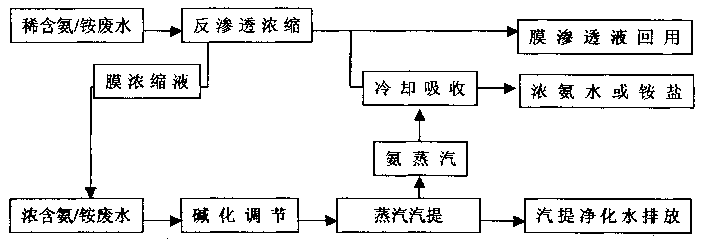Process for reclaiming ammonia-contained sewage
A recovery method and waste water technology, applied in water/sewage multi-stage treatment, water/sludge/sewage treatment, chemical instruments and methods, etc., can solve the problem of inability to use catalysts to treat ammonia-containing wastewater, large limitations, no recycling and Issues such as reuse value
- Summary
- Abstract
- Description
- Claims
- Application Information
AI Technical Summary
Problems solved by technology
Method used
Image
Examples
Embodiment 1
[0023] according to figure 1 In the process shown, the reverse osmosis device adopts cellulose acetate membrane, and the dilute ammonia / ammonium-containing wastewater is concentrated by two-stage reverse osmosis. The influent of the reverse osmosis stage, the average water permeability of the first and second stage reverse osmosis are respectively 95l / m 2 h, 110l / m 2 h, the average salt penetration rates are 95% and 98% respectively. The stripping device is a sieve plate column with a theoretical plate number of 13, and the stripping medium is steam at atmospheric pressure.
[0024] Dilute ammonium-containing wastewater: ammonium-containing wastewater (composed of NH 4 Cl: 0.48%, Na + : 1086μg / g, pH6.0) is pumped into the reverse osmosis device, the operating temperature is 35°C, the membrane inlet pressure is 3.7MPa, and the membrane outlet pressure is 3.3MPa. Obtained concentrate: concentration ratio 18.5%, NH 4 Cl2.50%, Na + 5640μg / g; membrane permeate: NH 4 + 3 μg...
Embodiment 2
[0027] according to figure 1 As shown in the process, the reverse osmosis device adopts polysulfone membrane, and the dilute ammonia / ammonium-containing wastewater is concentrated by three-stage reverse osmosis. Water, the concentrated solution of the 3rd stage and 2nd stage reverse osmosis flows back to the feed water of the 2nd stage and 1st stage reverse osmosis respectively, and the average water permeability of the 1st, 2nd, and 3rd stage reverse osmosis is respectively 92l / m 2 h, 104l / m 2 h, 114l / m 2 h, the average salt penetration rate is 95%, 97%, 99%. The stripping device is a sieve tray column with a theoretical plate number of 13, and the stripping medium is steam.
[0028] Dilute ammonium-containing wastewater: ammonium-containing wastewater (composed of NH 4 NO 3 : 0.43%, Na + : 986μg / g, pH4) pumped into the reverse osmosis device, the operating temperature is 45°C, the membrane inlet pressure is 3.7MPa, and the membrane outlet pressure is 3.4MPa. Obtained ...
PUM
 Login to View More
Login to View More Abstract
Description
Claims
Application Information
 Login to View More
Login to View More - R&D
- Intellectual Property
- Life Sciences
- Materials
- Tech Scout
- Unparalleled Data Quality
- Higher Quality Content
- 60% Fewer Hallucinations
Browse by: Latest US Patents, China's latest patents, Technical Efficacy Thesaurus, Application Domain, Technology Topic, Popular Technical Reports.
© 2025 PatSnap. All rights reserved.Legal|Privacy policy|Modern Slavery Act Transparency Statement|Sitemap|About US| Contact US: help@patsnap.com


